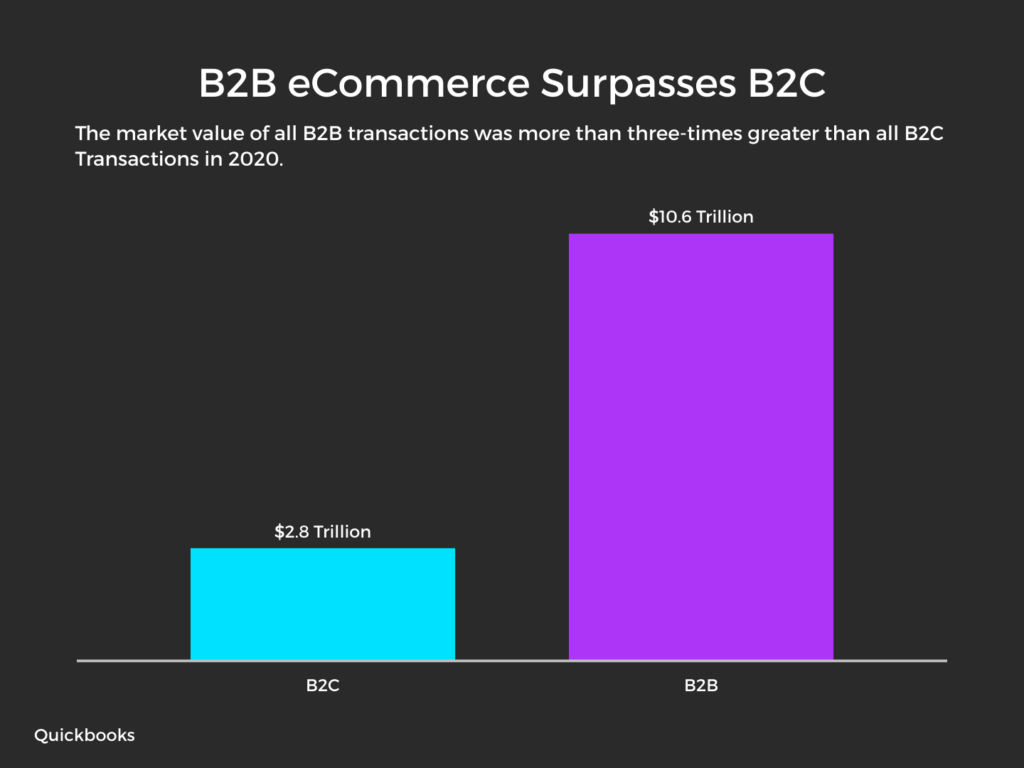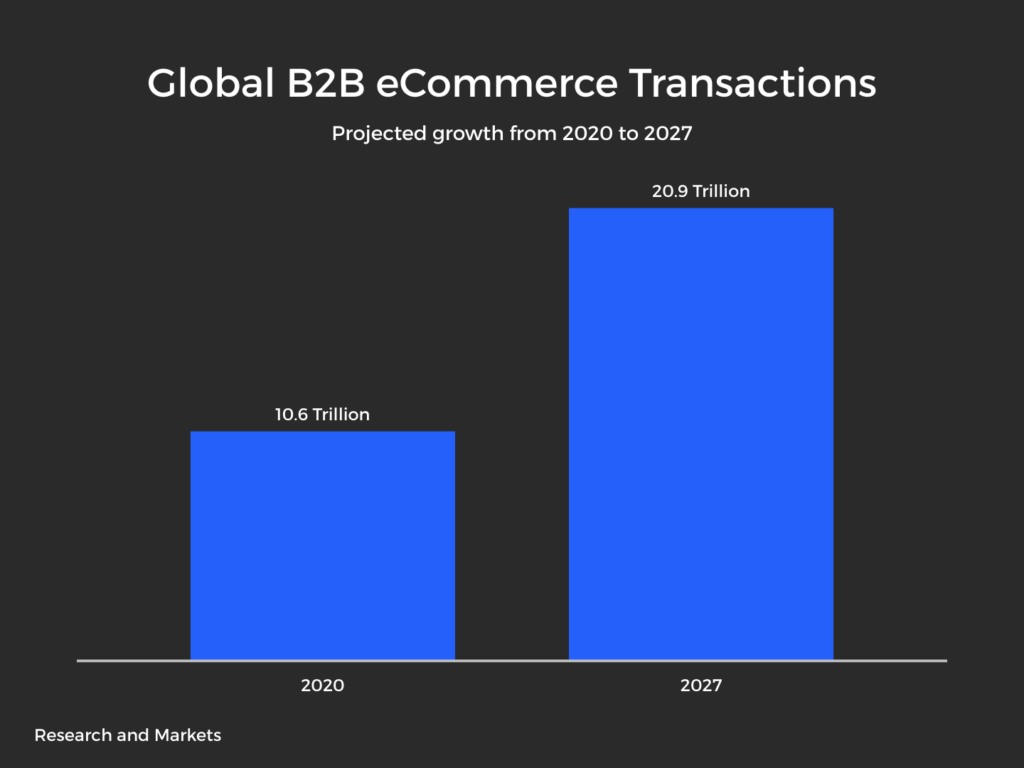B2B ecommerce owners are finding that digital commerce is just as critical or even more critical to them than to B2C companies.
Today’s B2B buyers are more likely to educate themselves, find solutions and buy online. The global B2B eCommerce market is over three times the size of the B2C market, and it’s expected to nearly double by 2027. To keep up with buyer expectations, companies must deliver frictionless online sales and payment experiences optimized for B2B buyers’ expectations. The best practices for B2B ecommerce found in this article can help you improve the online buying experience and meet evolving B2B buyer expectations.
Transitioning to an eCommerce Sales Model Is Increasingly Critical for B2B Companies
What Are Best Practices for B2B Ecommerce?
1. Allow Buyers to Self-Educate
Offer ways for your audience to self-educate. Include content such as blogs or ebooks on your website, video demos and self-guided tours that help answer their questions and advance the sales process.
2. Create Great On-Site Search Experiences
Search is critical for B2B sites. Visitors are less likely to just be browsing than in B2C scenarios. They need the ability to quickly and easily find exactly what they are looking for. Site search should be easy to use and deliver accurate and detailed results.
3. Provide Digital Invoicing at Checkout
Integrate payment methods such as bank transfers into digital invoices. When you offer options for different payment methods within your invoicing documents, you provide a more seamless experience for your customer.
4. Enable a Variety of International Payment Methods
One of the biggest opportunities with B2B sales is the chance to sell across international borders. In fact, the cross-border market for B2B sellers is poised to reach over $63,084 billion by 2026. (acumen) A key B2B ecommerce best practice for international expansion is to go beyond wire transfers, cards and invoicing and accept a variety of payment methods including bank transfers and ewallets.
5. Eradicate Unnecessary Barriers and Friction
Give users the ability to search items and do product research without a login. Don’t trip up your prospects by hiding your products and information behind a login screen. This only causes irritation. The fewer the steps to finding solutions, the better.
6. Personalize and Tokenize
Make it easier for customers to place an order by personalizing the experience. Reduce the number of required form fields and remember user information for easier repeat orders.
7. Avoid High Credit Card Fees
Credit card fees add up fast for large B2B purchases. What’s more, credit card purchase limits can result in lost opportunities. Instead, offer bank transfers, pay-by-invoice, and local payment methods to give buyers more options that work for them.
8. Offer Local Payment Methods
Moving beyond credit cards means offering bank transfers and other local payment methods. This will be easier on accounting teams to do reconciliation and avoid high credit card fees.
9. Provide Options for Bulk, Subscription and Scheduled Ordering
Regular customers are used to special agreements from salespeople. Smooth out the repeat order process with easy options for bulk orders, subscriptions and scheduled ordering to make it even easier to do business with you.
10. Enable Ordering and Sales Across Multiple Channels
Omni-channel enablement is yet another B2B ecommerce best practice to reduce friction and frustration at the customer level. To meet today’s buyers where they are with digital-first ordering, offer the ability for products, customer information and carts to synchronize among all their devices.
11. Unify Branding and Marketing
Your customers will find you through different channels. However, regardless of how they find your website, your branding must be unified and on point. To build a successful business your various platforms must be optimized and linked to each other, providing an omnichannel experience for your customers. Your marketing team must work together to ensure that your social media posts are in alignment with your email marketing and your website content marketing.
12. Keep Fraud, Risk and Compliance in Mind
As a B2B ecommerce business, you must know the regulations and laws for both your industry and your location. This might seem dry, but it can make or break your success. So take the time to do your homework and understand marketing regulations like GDPR in Europe as well as payment fraud best practices and compliance.
13. Organize and Document
An important best practice for any business is to document your workflows and processes. This is key as you build your team so that everyone knows what is expected of them and they can deliver uniform service to your customers. Your customers don’t want to wonder if each time they call customer service if they’ll get a different answer.
Your team can’t succeed if they’re constantly questioning how and when they should complete each step in your workflow. Take yourself out of the equation so you don’t have to micromanage your team and answer every question by organizing and documenting your entire workflow.
You might feel like you don’t have time to document your processes. But if you want to scale your business to the next level and see continued success you must take this step. This best practice will increase productivity and allow your business to grow and scale.
14. Choose a Payment Processing Solution Optimized for B2B
In the B2B arena, bulk orders and repeat orders are common practices. You want to make your customer experience as seamless as possible. So your payment solution must meet the demands of the B2B market.
Don’t settle for B2C solutions that may offer credit cards and consumer ewallets but fall short on the payment methods that reduce friction for B2B businesses, such as bank transfers and digital invoicing. You will see your conversions increase when you take the time to optimize your checkout process and ensure a secure process for your customers.
Additionally, if your business has a subscription model, you need to ensure that your payment service program can properly handle your subscription model.
15. Stay Committed to Your Why
Go back to your mission statement, where is it? Is it displayed prominently for everyone on your team to see and remember? Or is it buried deep in your business plan where nobody can find it?
If it’s the latter, then dig it out and dust it off. Just as Simon Sinek says, “you must remember your reason why you started your business. Why are you in business and how will you know when you’ve succeeded?” When the days feel long, and the sales start to lag, this is what will bring you and your team back to center and remind you why you’re doing this in the first place.
16. Build Trust
You need to showcase reviews and testimonials to build trust with your target market. Product reviews, testimonials or case studies are crucial, especially if you’re selling a large ticket item.
Businesses need to know that their investment is worthwhile and will give them the benefits they need. You can provide them this peace of mind through customer testimonials and case studies.
Trust badges displayed prominently on your website are also a crucial best practice to build trust with your customers and clients. If you’re an authorized reseller of a particular brand or if you’re accredited by trade organizations, these are great examples of trust badges you can display on your website. They ensure your customers that you can be trusted with their business.
17. Don’t Skimp on Site Search Technology
In B2B, website search is even more critical than in B2C ecommerce. While many B2C website visitors may just be browsing. B2B visitors often have purchase intent and are looking for the information, products and details they need to make an informed decision. Solutions like Add Search can help your website to deliver quality content that answers your customers’ questions.
Document Your B2B eCommerce Best Practices
By having the right best practices in place, your team members can act with confidence knowing they’re doing the right process at the right time for your organization. And if your team is spread out across the globe, it’s even more important to have this documented and shared where everyone can access them regularly.
Documented best practices will help your team to:
- Avoid mistakes
- Increase productivity and performance
- Save money and reduce operating costs
How to Create a Winning B2B eCommerce Strategy
Just as Marcus Lemonis says in his hit show on CNBC, business success comes down to the three P’s: people, product, and process. The same is even more true in ecommerce best practices.
The top B2B ecommerce website best practices will focus on these three key areas to see winning success. As a successful ecommerce business, you’ve spent countless hours ensuring that you deliver the best products possible to your customers.
To create a successful strategy you must also spend as much time focusing on the people in your business. This includes both your team members and customers. Take the time to build up and encourage your team members. And then also ensure that your website, emails, and social media profiles all provide value through helpful content.
Lastly, you must have the right processes in place to ensure seamless and timely delivery of your product. For instance, if your customers don’t receive an immediate confirmation of their purchase, and an email with a copy of their receipt and shipping information, your customer service department could be overrun with questions that could have been avoided. As a B2B ecommerce business, you’re never done building and growing. Establishing and optimizing best practices for your organization is an ongoing activity that should be frequently revisited and evaluated.
For More In-Depth eCommerce Tips, Download Our Free Digital Commerce Playbook
Sources:
Acumen Research & Consulting. “B2B Payments Transaction Market.” 2019, https://www.acumenresearchandconsulting.com/b2b-payments-transaction-market.
Quickbooks. B2B eCommerce market size and statistics. Intuit Quickbooks. https://www.tradegecko.com/, https://www.tradegecko.com/b2b-ecommerce#:~:text=to%20get%20there.-,B2B%20eCommerce%20market%20size%20and%20statistics,that%20number%20hit%20%2412.2%20trillion.
Research and Markets. “Business-To-Business E-Commerce Market Size, Share & Trends Analysis Report by Deployment Model, by Application, by Region, and Segment
Photo by Nataliya Vaitkevich, Pexels
Your All-In-One Solution For Local and International B2B Payments and Payouts
Power your B2B ecommerce initiative with a customized checkout experience that lets business customers pay with their preferred methods.
Payment and payout methods that drive global businesses:
- Accept global ACH, cards, virtual accounts and cash payments
- Disburse funds using wires, global ACH and even issue your own cards
- Better manage the complexity of your international receivables with payment methods that can help lower your days sales outstanding (DSO).
Subscribe Via Email
Thank You!
You’ve Been Subscribed.





